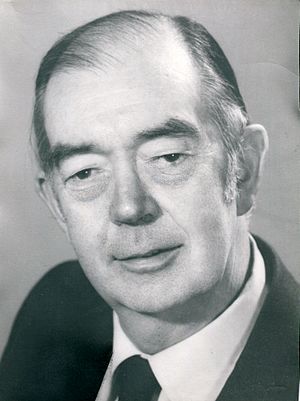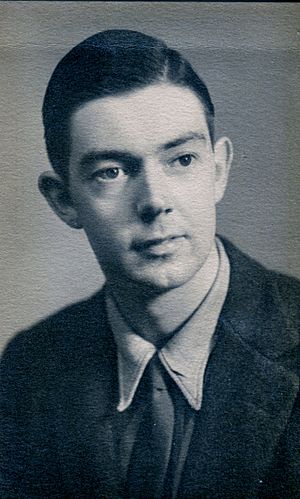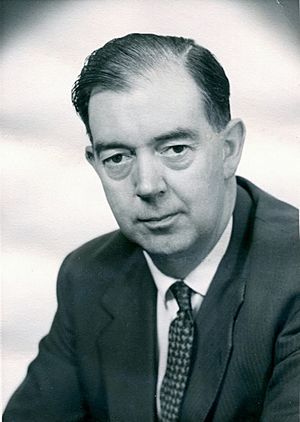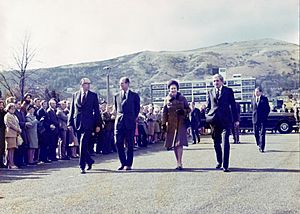John Robert Mills facts for kids
Quick facts for kids
John Mills
|
|
|---|---|

John Mills aged 60 in 1976
|
|
| Born | 12 November 1916 Barnes, Surrey, England
|
| Died | 6 May 1998 (aged 81) Malvern, Worcestershire, England
|
| Alma mater | King's College London |
| Spouse(s) |
Pauline Phelps
(m. 1950) |
| Children | Two sons |
| Awards | 1971 Fellow IEE (Now IET since 2006 ) |
| Scientific career | |
| Fields | Defence Scientist Specialist in: Radar, Military Communications and Navigation Systems |
| Institutions | AMRE, Dundee RAE, Farnbourough TRE, RRE, Malvern Min Tech, London SRDE, Christchurch RSRE, Malvern |
John Robert Mills (born November 12, 1916 – died May 6, 1998) was a British scientist. He was a physicist and an expert who helped develop radar technology. This technology was very important for Britain's defense during World War II. After the war, he kept working on many different science projects for the British government until he retired in 1977.
One of his amazing achievements was being the first British scientist to receive radio signals that had bounced off the Moon!
Contents
Early Life and Education
John Mills went to Kingston upon Thames Grammar School. After that, he studied physics at King's College London. He earned his science degree (BSc) in 1939.
Right after college, in 1939, he started working for the Air Ministry Research Establishment in Dundee. In 1940, he moved to the Royal Aircraft Establishment (RAE) in Farnborough. Then, in 1942, he joined the Telecommunications Research Establishment (TRE) in Malvern. This place later changed its name to the Royal Radar Establishment (RRE). He worked there for a long time, until 1960.
Developing Radar Technology
John Mills was part of a special team during World War II. This team helped make radar a very important tool for defense. Radar helped protect Britain, especially against enemy aircraft. It also became useful for guiding planes.
His team worked on air navigation systems. Later, as part of the Airborne Radar Division at RRE, he helped create infra-red and radar systems. These systems were used for targeting and finding things for the Royal Air Force and Royal Navy.
The equipment they developed was improved for the V bomber force. It was also used in the BAC TSR-2, which was a very advanced aircraft. Mills also helped create the first successful sideways-looking radar. This type of radar was later improved by the US. It even led to the satellite radar systems we use today.
After 1960, Mills spent about a year at the Ministry of Defence (MOD) in London. Then, he became the head of the Radio Department at RAE Farnborough for five years. Here, he was in charge of several important projects:
- Electronic warfare systems, which help protect against enemy electronics.
- Very Low Frequency (VLF) navigation, which led to the Omega system. This system helped ships and planes find their way.
- Studies on how radio waves travel.
During this time, his team received the first message ever bounced off the Moon from the United States. This amazing work eventually led to the modern satellite communication systems we use every day. He also helped develop the first system that could land an aircraft automatically.
In 1966, John Mills was chosen to be a Scientific Adviser to the Minister of Technology.
Leading Research and Development
From 1967 to 1976, Mills was the director of the Signals Research and Development Establishment (SRDE) in Christchurch. He was responsible for three main areas of research:
- Night Vision Devices: These were mainly for the British Army. They used special technology to help soldiers see in the dark. This included rifle sights and systems for tanks and other vehicles.
- Radio and Communication Systems: He worked on tactical and strategic radio networks. Some of these, like the Clansman radio, were used by the military until the early 2000s.
- Military Satellite Communication: This focused on making small, portable ground terminals for mobile use. An example is the Ptarmigan system.
In 1971, Mills became a Fellow of the Institution of Electrical Engineers (IEE). This is a very high honor for engineers.
Final Years and Retirement
In 1976, John Mills returned to Malvern. He became the Deputy Director of the Royal Signals and Radar Establishment (RSRE). This new establishment was formed by combining several research centers. His team continued to work on advanced military and satellite communication systems.
John Mills held this important position until he retired in 1977.
Personal Life
John Mills married Pauline Phelps in April 1950. He was a dedicated family man. He also had strong interests in music and gardening. He passed away in 1998 and was survived by his wife and two sons.




